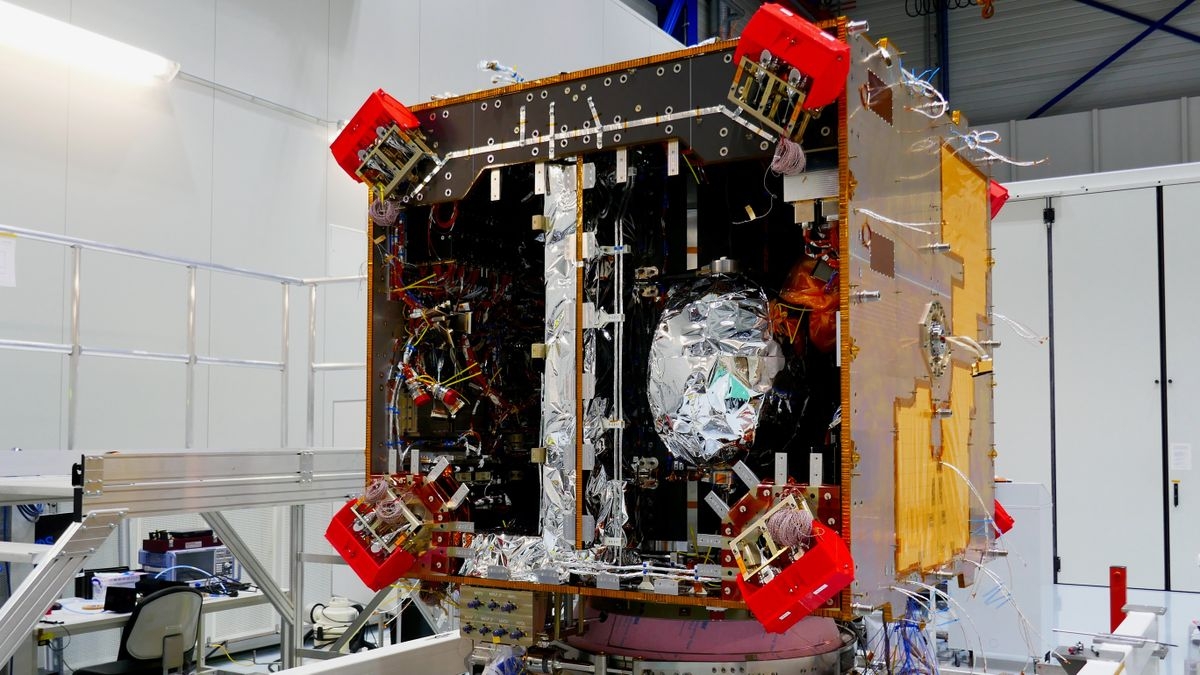Space
 www.space.com
www.space.com
## Summary The Hera spacecraft has recently been assembled in [Bremen, Germany](https://en.wikipedia.org/wiki/Bremen,_Germany) by [OHB](https://en.wikipedia.org/wiki/OHB_SE). Its mission is to observe the result of [NASA](https://en.wikipedia.org/wiki/NASA)ʼs [DART](https://en.wikipedia.org/wiki/Double_Asteroid_Redirection_Test) mission which impacted [Dimorphos](https://en.wikipedia.org/wiki/Dimorphos) in 2022-09. The Hera spacecraft will now be sent to the Netherlands for testing by the [European Space Agency](https://en.wikipedia.org/wiki/European_Space_Agency) (ESA). The craft is scheduled to be launched by [SpaceX](https://en.wikipedia.org/wiki/SpaceX) from [Cape Canaveral](https://en.wikipedia.org/wiki/Cape_Canaveral) on 2024-10. ## Stats * Author: [Andrew Jones](https://www.space.com/author/andrew-jones) * Date: 2023-09-05 * Work: *space.com* * Accessed: 2023-09-05 ## Further Reading * Patrick Michel, et. al. (2022-07). “[The ESA Hera Mission: Detailed Characterization of the DART Impact Outcome and of the Binary Asteroid (65803) Didymos](https://doi.org/10.3847/PSJ/ac6f52)”. *The Planetary Science Journal*, Volume 3, Number 7, Page 160. DOI: [https://doi.org/10.3847/PSJ/ac6f52](https://doi.org/10.3847/PSJ/ac6f52) . Accessed 2023-09-05. License: [🅭🅯 4.0](https://creativecommons.org/licenses/by/4.0/).

> [Unlike (the now crashed) Luna-25 lander, CH3 does not have a Radioisotope RTG that can provide heating and power during the lunar night.](https://fosstodon.org/@AkaSci/110934895964992012) >[Given that Chandrayaan-3 is at 69.37° S latitude, the maximum elevation is around 20°. Hence the near-vertical orientation of the solar panels on the lander and the rover. The Sun will disappear below the horizon and the mission will come to an end around Sep 4.](https://fosstodon.org/@AkaSci/110952854892771705) - [Moon daylight calculator](https://the-moon.us/wiki/Sun_Angle) - [ISRO mission brochure](https://www.isro.gov.in/media_isro/pdf/Missions/LVM3/LVM3M4_Chandrayaan3_brochure.pdf); i.e. no [Radioisotope thermoelectric generator (RTG)](https://en.wikipedia.org/wiki/Radioisotope_thermoelectric_generator), only 738 W solar panels
 www.nytimes.com
www.nytimes.com
- [YouTube](https://www.youtube.com/watch?v=DLA_64yz8Ss) - News coverage - [NYTimes](https://www.nytimes.com/2023/08/22/science/india-moon-landing-chandrayaan-3-watch.html?unlocked_article_code=VTW0_IB3CLc5uWis_pmVe0koxfQpQfB_mWHIOBnhEoFStiszpVJfPwgPfV6FywnvurSpBVCDW2ORl53gz_ygEGy9OGz5m8wy7pHE99GMk3v1JiBWY89k3Sz0-9IEYryIYgd0wj3NC6ayvYyvLC-DJsIzKSiWNPjpMfoEDetNWQkJNhKh86bfGwnMAbj3gSEjnbYm11d4BW9aVndY-TUf3pPhyAHbctGZq-2c7-Jxh33jjJitn62_hBnGxR3-uRAjE8bHL0Slc1CsuVdHfXL27iIOUuu7sC_OZcGzG_746uUS_Ah1B9qZdu8-02qBTaYrNxZvOz1Mh32MabdlphfCRfdIm469ShUwBxSiQcU2jr4&smid=url-share) - [BBC](https://www.bbc.com/news/live/world-asia-india-66576580) - [Indian Space Research Organization (ISRO)](https://www.isro.gov.in) - [Twitter](https://twitter.com/isro) - Time: - `2023-08-23T12:34+00` (UTC) - `2023-08-23T05:34-07` (Los Angeles) - `2023-08-23T08:34-04` (New York) - `2023-08-23T15:34+03` (Helsinki) - `2023-08-23T15:34+03` (Kyiv) - `2023-08-23T18:04+05:30` (Delhi) - `2023-08-23T19:34+07` (Jakarta) - `2023-08-23T20:34+08` (Beijing) - `2023-08-23T22:34+10` (Sydney) ## What is Chandrayaan-3? Chandrayaan means “moon craft” in Hindi. In addition to the propulsion module that pushed the spacecraft into orbit around the moon, the landing module consists of the Vikram lander and the Pragyan rover that will attempt to set down on the lunar surface in the moon’s south polar region. The mission is robotic and there are no astronauts aboard. The Aug. 23 landing was selected because it is the day when the sun will rise at the landing site. The mission is to conclude two weeks later when the sun sets. While on the surface, the solar-powered lander and rover will use a range of instruments to make thermal, seismic and mineralogical measurements.
